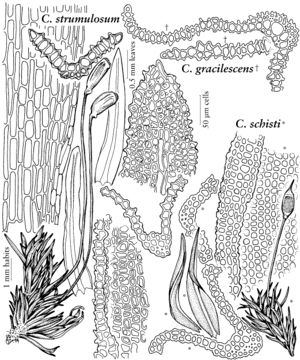Cynodontium gracilescens
Coroll. Bryol. Eur., 12. 1856,.
Stems to 5 cm. Leaves to 3 mm, long ovatelanceolate, gradually narrowed from a broadly ovate base, apex blunt or sometimes acute; margins somewhat recurved, 2-stratose only in the distal portion of the leaf; laminal cells both mammillose and spinose (strongly mammillose-papillose) on both surfaces, distal leaf cells thin-walled, irregularly rounded-quadrate, ca. 10 µm wide. Perigonium sessile. Seta ca. 1.5 cm, curved-cygneous when wet, nearly straight when dry. Capsule straight and erect, not strumose; annulus weakly developed, of small persistent cells.
Phenology: Capsules mature summer.
Habitat: Moist, shaded ledges, rock crevices
Elevation: moderate to high elevations
Distribution
Greenland, N.W.T., Ont., Colo., Eurasia
Discussion
The bistratose distal leaf margins, the swan-necked (cygneous) curved seta when wet, as well as the distinctly striate-furrowed capsule are all characteristic of the autoicous Cynodontium gracilescens. The seta ranges from cygneous, with the capsule pendent, to arched or bowed, with the capsule more inclined to the horizontal. The seta curved when wet is reminiscent of the closely related but smooth-celled Oreas martiana, the seta of which behaves in similar fashion, as do those of several species of Seligeria (Seligeriaceae), such as S. campylopoda. The costa of C. gracilescens is papillose abaxially nearly throughout. The dioicous Dichodontium pellucidum may be very similar in strongly horned-papillose distal laminal cells but this occurs only in variants with a short and broad leaf with a broadly rounded or broadly acute apex. In the long-linear leaved form of D. pellucidum, the papillae are low or the cells are nearly smooth; in either form the margins are unistratose. Oreas has strongly striated capsules that are nearly globose, and undivided peristome teeth. Cynodontium fallax Limpricht has not been reported for the flora area but may be expected. This Eurasian species has an erect seta when wet, leaf apices more narrowly pointed than those of C. gracilescens, and larger distal laminal cells (9–14 µm) that are nearly smooth on the abaxial surface. In C. gracilescens the leaf apices are more broadly pointed, while distal laminal cells are smaller (7–11 µm) and coarsely mammillose on both adaxial and abaxial surfaces. Specimens of the latter from North America also have bistratose patches on the lamina. H. A. Crum and L. E. Anderson (1981) considered this species to be absent from eastern North America.
Selected References
None.
